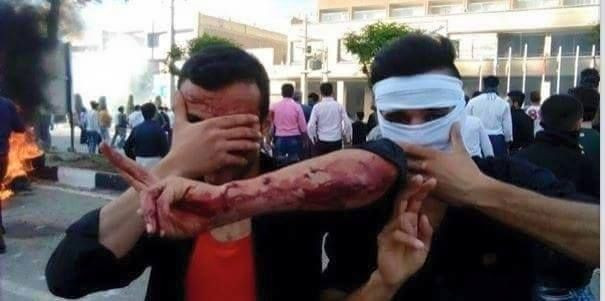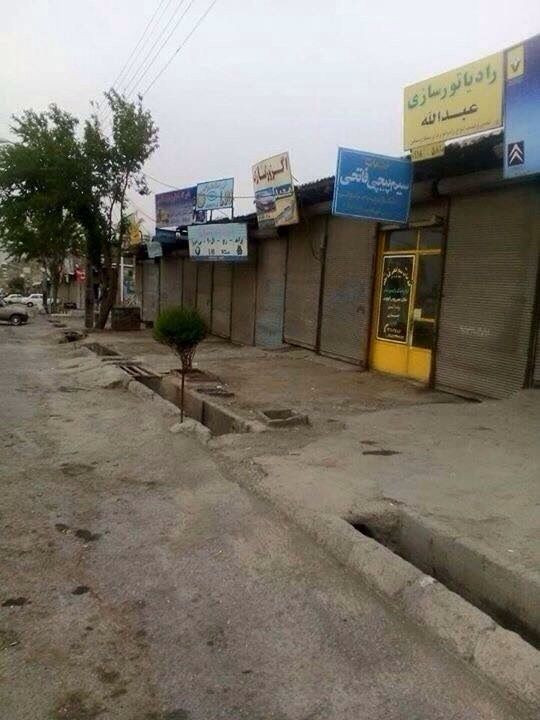The Iranian Kurdish 'Revolution' The World Doesn't Know Is Happening

Editor's note: This article contains potentially disturbing photos.
Buildings are burning, protesters are bloodied, law enforcement vehicles are destroyed, hundreds of young men and women have been arrested and there is no end in sight. Iranian Kurdistan has been under what Iranian opposition called an “undeclared martial law” for the last week, and the Iranian regime has done all it can to keep it out of the media.
Thousands of Iranian Kurds have been demonstrating in the streets of roughly a dozen Iranian cities almost consistently for the past week. On Friday, protests turned violent as Iranian Kurdish political leaders called for an independent Kurdistan and democracy in Iran. It is one of the biggest Kurdish uprisings against the Iranian regime in years.
Iranian Kurds are “planning to carry out a comprehensive revolution and there are armed Iranian Kurdish political parties positioning themselves for the revolution,” said Sarkawt Kamal Ali, an Iraqi human rights lawyer familiar with the Kurdish situation.
On Friday, a recently formed coalition of Kurdish political parties, Kodar, threatened to deploy protesters and militia fighters to the Iranian capital of Tehran if the regime did not allow them to independently govern Iran’s Kurdish areas, according to Rudaw.
The initial protests against the regime’s oppression of Kurds began after a May 4 incident in which 27-year-old Farinaz Khosravani jumped to her death from a window when an Iranian intelligence officer allegedly tried to rape her at the hotel where she worked in the Kurdish city of Mahabad. Later, regime-affiliated social media accounts and news outlets circulated a video allegedly showing Khosravani “voluntarily” engaging in sexual acts with the officer, sources close to the issue told International Business Times.
“Whatever happened, it ignited a very significant outburst ... by the Kurds in the city,” said Dave Pollock, a Kaufman Fellow at the Washington Institute whose research focuses on public opinion and media content in the region. He added that Mahabad “is not a gigantic city but it’s enough to provide the critical mass for a very large demonstration. But it was forcibly suppressed.”
The Iranian regime is known for its intolerance of anti-regime sentiment of any kind, and its anti-riot tactics include shutting off the Internet, wireless services and other means of communication in addition to banning reporters from the area. This means the Iranian Kurdish “revolution” has not yet been televised, but much like the uprisings in Syria and Egypt, it is being broadcasted on social media.
When demonstrations began on May 7 in Mahabad, S.Kurdax, a Syrian Kurd whose name has been changed for security reasons who was also forced to flee his own country when President Bashar Assad’s regime began arresting protesters in 2011, wanted to help. Along with several other Kurdish friends from the region, he created various social media accounts to provide accurate information from the ground in Iran, where many of his friends are demonstrating.
“We as young people, as Kurds, we have to put the news on Twitter, Facebook and Skype,” Kurdax told IBTimes via Skype. “We tell the truth for our people.”
His main news outlet is Facebook, where his page “Kurdish Revolution in Iran” has garnered more than 14,000 followers in less than two weeks. Kurdax said his group is organizing a “big revolution” in Iran for next Friday, but they are urging demonstrators not to resort to violence.
“We are trying to make it just revolution. Shooting and streaming videos and making a general strike against the regime in Iran,” Kurdax said. “If we try to fight this regime, they are so dangerous. They have chemical weapons and bombs.”
Since Khosravani’s death, Iran’s Law Enforcement Force has arrested hundreds of Kurdish youth in cities spanning the Iranian Kurdistan region on the border with Iraq. Iran’s Ministry of Intelligence and Security has reportedly dispatched a “group of henchmen to torture and interrogate” the detainees, according to the National Council of Resistance of Iran, a coalition of opposition groups that describes itself as a “parliament-in-exile.”
Protests seemed to calm down in the days following Khosravani’s death, but they picked up speed this week, as Kurds around the world showed their solidarity with the Iranian cause. On Thursday, demonstrations were held in front of the Iranian embassies in several European cities, including Vienna, Paris and London. Meanwhile, at least 14 cities in Iranian Kurdistan held a general strike to protest the arrests earlier in the week.

Demonstrations turned violent again on Friday when protesters reportedly placed explosive devices in Iranian law enforcement vehicles, in an attempt to block the convoy from entering the protest area. The armored trucks exploded, killing and injuring more than a dozen people, several sources familiar with the situation told IBTimes.
Hundreds of demonstrators and Iranian law enforcement have reportedly been injured since the clashes began. Recent reports from the ground claimed that the officer accused of attempted rape was killed in the clashes, but IBTimes was unable to confirm that.
There are an estimated 7 million Kurds concentrated in what used to be part of Kurdistan and is now Iranian territory on the border with Iraq. They have long been denied basic human rights in Iran and it has only become worse since the Iranian Revolution of 1979. The Kurdish language is, however, not banned in Iran as has been in other countries in the region.

“The pace of the Iranian government’s oppression of Kurdish expression, including executions of community organizers, political figures and dissidents, has really picked up in the last year or two,” Pollock said.
Earlier this year, Amnesty International released a report that said Kurds make up the most executions per year compared to every other minority. And it seems Iranian Kurds have finally had enough of the regime’s oppression.
“The Kurdish street is angry. It was like a volcano in our Kurdish hearts,” Kurdax said, referencing “Arab street,” the term used to describe public opinion across Arab countries. “We just want our rights. We are also human.”
Correction: A previous version of this article incorrectly stated that the Kurdish language was banned in Iran.
© Copyright IBTimes 2024. All rights reserved.





















